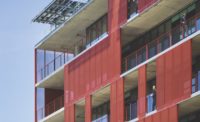With its silvery metal panels and glass cladding, and a canted photovoltaic (PV) array that projects beyond the edges of the roof like the brim of a hat, the recently completed six-story Bullitt Center in Seattle’s Capitol Hill neighborhood doesn’t at all resemble a Douglas-fir forest, admits Denis Hayes. Nevertheless, Hayes, who is president and CEO of the Bullitt Foundation, is fond of comparing the 52,000-square-foot office building to just such a forest. “It functions like one,” he maintains.
Appearances aside, Hayes’s metaphor is apt. If the $18.5 million building operates as intended, it will be self-sufficient in much the same way a forest is: It will obtain all its water from the rain that falls on the site, and over the course of a year, will consume no more electricity than is generated by the roof’s PVs.
The Bullitt, which claims to be the world’s greenest commercial building, officially opens today with a ribbon cutting ceremony to be attended by Jay Inslee, the governor of Washington State, and Michael McGinn, Seattle’s mayor. It is aiming for Living Building Challenge (LBC) certification—a rigorous process that entails satisfying 20 tough-to-achieve “imperatives” and requires a year’s worth of post-occupancy data to demonstrate net-zero operations for energy and water. Since LBC’s launch in 2006, only four buildings have achieved living building status. Approximately 150 other projects, located all over the world, are registered with the LBC program, administered by the International Living Future Institute (ILFI).
Tenants began moving into the Bullitt earlier this year. Many, such as ILFI; the property’s developer, Point 32; and the building’s m/e/p engineer, PAE, have some connection to the project. These organizations have sustainability in their DNA, and might be willing to put up with some inconvenience for the sake of the environment. However, Hayes was determined to create a comfortable workplace. “Denis was clear that it couldn’t be too much of a hippie experience,” says Craig Curtis, a partner at Miller Hull, the Bullitt’s architect. “It had to be a place where people would want to be and want to work,” he says.
Toward that end, the project team devised a heavy-timber frame, with its handsome components, including laminated beams and wood deck ceilings, left largely exposed. The designers gave the Bullitt 14-foot floor-to-floor heights and correspondingly tall, but thermally efficient glazing—a configuration that allows daylight to penetrate deep into the interior. And they transformed an egress stair into the “irresistible stair.” The glass-enclosed space is a prominent feature of the facade, providing stunning views of the city’s skyline.
The climate control system at Bullitt depends on natural ventilation and automated operable windows. But when it is too hot or too cold to open these windows, a heat-recovery ventilator kicks in. For space heating and cooling, a radiant floor system taps the consistent temperature of the earth, via 26 geothermal wells, each 400 feet deep.
The building and these systems are designed to be extremely energy efficient, with an energy use intensity about 80 percent below an average office building. However, the margin between the power expected from the 242 kW PV array and estimated demand is razor thin—only 2 to 3 percent, say the designers. They predict that almost half of the electricity will be consumed by devices like printers, computers, and appliances—the so-called “plug loads” over which landlords typically have little control. To keep these loads in check, each tenant has agreed to an energy allowance as part of its lease.
The limits have prompted tenants to closely monitor their operations. In preparation for its move, PAE analyzed its own electricity use. “We found we were using too much energy for the building we were designing,” says firm president, Paul Schwer. PAE has since revamped its IT infrastructure and replaced equipment.
Realizing the project required clearing many regulatory hurdles. For example, providing enough PV panels to bring the net-zero energy goal within reach in cloudy Seattle meant an array covering 14,000 square feet, projecting as much as 20 feet beyond the building’s perimeter. This extension over the public right of way involved a special allowance from Seattle’s Department of Planning and Development.
Still under way are negotiations with the local utility and the state department of health to designate the building as its own water district. If granted this status, the Bullitt will use rainwater collected from the roof and stored in a 56,000-gallon cistern in the basement to supply showers, sinks, and water fountains—after it undergoes a multi-step filtering and purification process. In the meantime, the project has an exemption from ILFI allowing it to rely on the municipal utility for potable uses, but still satisfy the net-zero water imperative. The building’s other water-conserving strategies include irrigation that utilizes grey water and the world’s only six-story composting toilet system.









Post a comment to this article
Report Abusive Comment